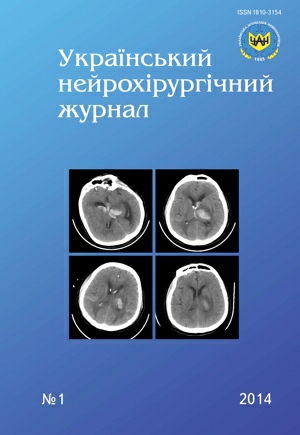Prognostic criteria of patients’ survival at malignant craniofacial tumors
DOI:
https://doi.org/10.25305/unj.51529Keywords:
craniofacial tumors, malignant tumors, surgery, prognosisAbstract
Introduction. Taking into account that malignant tumors often recur, determining prognostically significant criteria makes it possible to improve the treatment strategy, justify the indications for surgery, and to increase the overall patients’ survival.
Materials and methods. In a period from 2002 to 2012 treatment results of 133 patients with malignant craniofacial tumors were analyzed.
Results. Study of intracranial or sometimes intracerebral spread of malignancies, dura mater invasion or concretion, as well as resection are the basis of prognostic factors in surgery of craniofacial tumors. It was found that the patients’ survival rates did not depend on these factors and the histological type of the tumor. They depend upon such factors as disease duration, patient’s age, tumor invasion, growth of tumor tissue around the eye hole. 3 years survival was 53%, 5 years — 38%. After surgery all patients were alive. Complications occurred in 19 (14%) patients.
Conclusion. Accounting for prognostic factors gives an opportunity to increase overall survival rates, to reduce the incidence of postoperative complications, avoid postoperative mortality.
References
1. Zabolotnyj DI, Lukach EV, Dikhtiaryk VYa, Latyshevs’ka GV, Serezhko YO, Tsymbaliuk EM, Zajtseva NV, Strizhak VV, Kutsenko LB. Efektyvnist diahnostyky ta likuvannya khvorykh iz zloyakisnymy pukhlynamy porozhnyny nosa ta prynosovykh pazukh v Ukrayini u 2002–2004 rokakh [The effectiveness of diagnosis and treatment in patients with malignant tumors of the nasal cavity and paranasal sinuses in Ukraine in 2002-2004]. Zhurn Vushn Nosovykh i Gorlovykh Khvorob. 2010;3:51-55. Ukrainian.
2. Taniashin SV. Khirurgicheskiye aspekty lecheniya zlokachestvennykh opukholey, porazhayushchikh osnovaniye cherepa [Surgical aspects of treatment of the malignant tumors affecting skull base] [dissertation]. Moscow (Russia) Burdenko Neurosurgery Institute; 2005. Russian.
3. Cantu G, Riccio S, Bimbi G, Squadrelli M, Colombo S, Compan A, Rosi M, Pompilio M, Solero C. Craniofacial resection for malignant tumors involving the anterior skull base. Eur Arch Otorhinolaryngol Head Neck. 2006;263(7):647-52. [PubMed] [CrossRef]
4. Cantu G, Solero CL, Miceli R, Mattana F, Riccio S, Colombo S, Pompilio M, Lombardo G, Formillo P, Quattrone P. Anterior craniofacial resection for malignant paranasal tumors: a monoinstitutional experience of 366 cases. Head Neck. 2012;34(1):78-87. [PubMed] [CrossRef]
5. Daele JJ, Vander Poorten V, Rombaux P, Hamoir M. Cancer of the nasal vestibule, nasal cavity and paranasal sinuses. B-ENT. 2005;(1):87-96. [PubMed]
6. Feiz-Erfan I, Suki D, Hanna E, DeMonte F. Prognostic significance of transdural invasion of cranial base malignancies in patients undergoing craniofacial resection. Neurosurgery. 2007;61(6):1178-85. [PubMed] [CrossRef]
7. Iseh KR, Amutta SB, Shehu BB, Nasir J. Combined transfacial and transcranial approach for tumours of the nose and paranasal sinuses with intracranial extension. Niger J. Med. 2011;20(2):216-9. [PubMed]
8. Zajtsev AM. Kraniofatsial'nyye blok-rezektsii pri zlokachestvennykh opukholyakh osnovaniya cherepa. Tekhnika, blizhayshiye i otdalennyye rezul'taty [Craniofacial block at resection of malignant tumors of the skull base. Technique, early and late results] [dissertation]. Moscow (Russia): Burdenko Neurosurgery Institute; 2004. Russian.
9. Cherekaev VA. Khirurgiya opukholey osnovaniya cherepa, rasprostranyayushchikhsya v glaznitsu i okolonosovyye pazukhi [Surgery of the skull base tumors spreading into the orbit and paranasal sinuses] [dissertation]. Moscow (Russia): Burdenko Neurosurgery Institute; 1995. Russian.
10. Bilsky MH, Bentz B, Vitaz T, Shah J, Kraus D. Craniofacial resection for cranial base malignancies involving the infratemporal fossa. Neurosurgery. 2005;57(4):339-447. [PubMed] [CrossRef]
11. Gil Z, Patel SG, Bilsky M, Shah JP, Kraus DH. Complications after craniofacial resection for malignant tumors: are complication trends changing. Otolaryngol Head Neck Surg. 2009;140(2):218-23. [PubMed] [CrossRef]
12. Ladzinski P, Majchrzak H, Kaspera W, Maliszewski M, Majchrzak K, Tymowski M, Adamczyk P. Direct and remote outcome after treatment of tumours involving the central skull base with the extended subfrontal approach. Neurol Neurochir Pol. 2009;43(1):22-35. [PubMed]
13. Licitra L, Locati LD, Cavina R, Garassino I, Mattavelli F, Pizzi N, Quatrone P, Valagussa P, Gianni L, Bonadonna G, Slero CL, Cantu G. Primary chemotherary followed by anterior craniofacial resection and radiotherapy for paranasal cancer. Ann Oncol. 2003;14(3):367-72. [PubMed]
14. Eisen MD, Yousem DM, Loevner LA, Thaler ER, Bilker WB, Goldberg AN. Preoperative imaging to predict orbital invasion by tumor. Head Neck. 2000;22(5):456-62. [PubMed] [CrossRef]
15. Ganly I, Patel SG, Singh B, Kraus DH, Dringer PG, Cantu G, Cheesman A, De Sa G, Donald P, Fliss D, Gullane P, Janecka I, Kamata SE, Kowalski LP, Levine P, Medina LR, Pradhan S, Schramm V, Snyderman C, Wei WI, Shah JP. Complications of craniofacial resection for malignant tumors of the skull base: Report of an International Collaborative Study. Head Neck. 2005;27(6):445-51. [PubMed]
16. Origitano TC, Petruzzelli GJ, Leonetti JP, Vandevender D. Combined anterior and anterolateral approaches to the cranial base: complication analysis, avoidance, and management. Neurosurgery. 2006;58(4):327-37. [PubMed] [CrossRef]
17. Tagli A, Ali A, Clarke P. Craniofacial resection and its role in the management of sinonasal malignancies. Expert Rev Anticancer Ther. 2012;12(9):1169-76. [PubMed] [CrossRef]
18. Wagenmann M, Schipper J. The transnasal approach to the skull base. From sinus surgery to skull base surgery. Otorhinolaryngol. Head Neck Surg. 2011;3:Doc08. [PubMed] [CrossRef]
Published
How to Cite
Issue
Section
License
Copyright (c) 2014 Orest Palamar, Andriy Huk

This work is licensed under a Creative Commons Attribution 4.0 International License.
Ukrainian Neurosurgical Journal abides by the CREATIVE COMMONS copyright rights and permissions for open access journals.
Authors, who are published in this Journal, agree to the following conditions:
1. The authors reserve the right to authorship of the work and pass the first publication right of this work to the Journal under the terms of Creative Commons Attribution License, which allows others to freely distribute the published research with the obligatory reference to the authors of the original work and the first publication of the work in this Journal.
2. The authors have the right to conclude separate supplement agreements that relate to non-exclusive work distribution in the form of which it has been published by the Journal (for example, to upload the work to the online storage of the Journal or publish it as part of a monograph), provided that the reference to the first publication of the work in this Journal is included.









